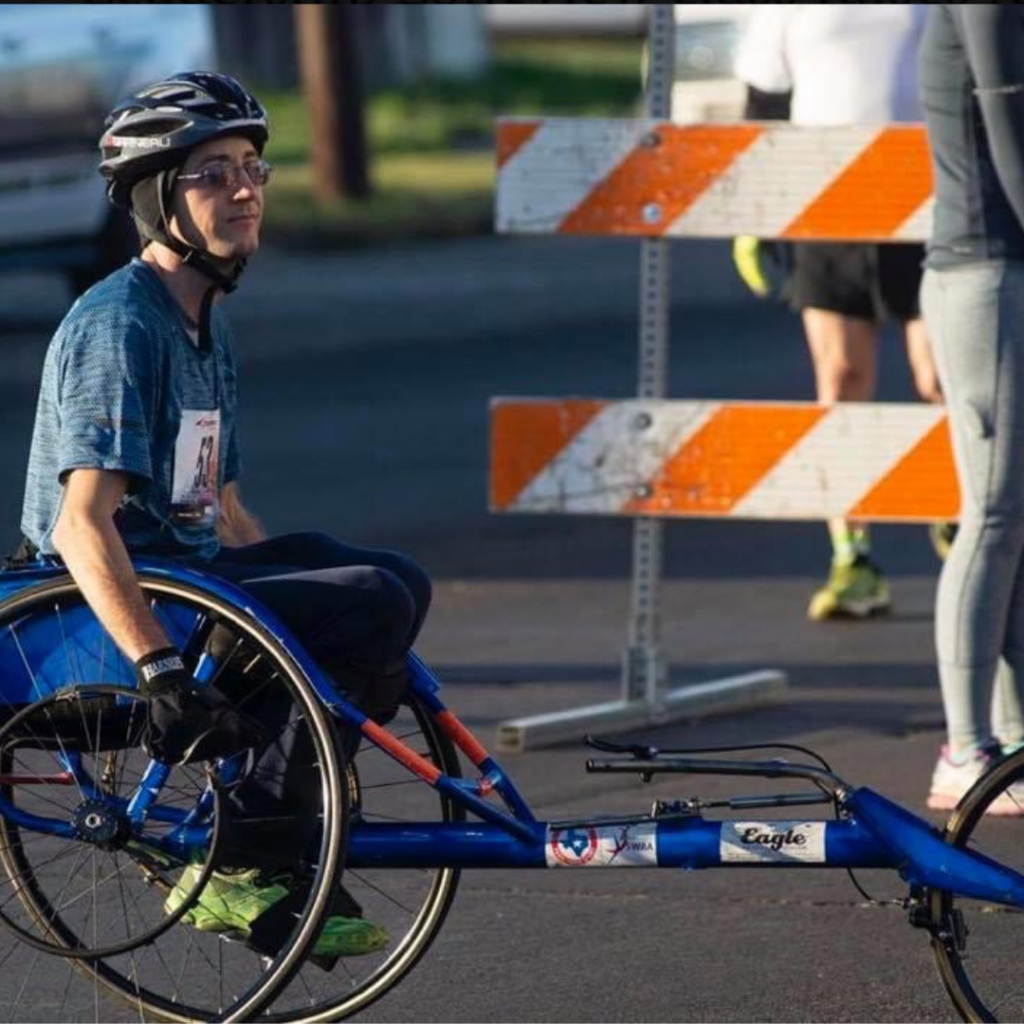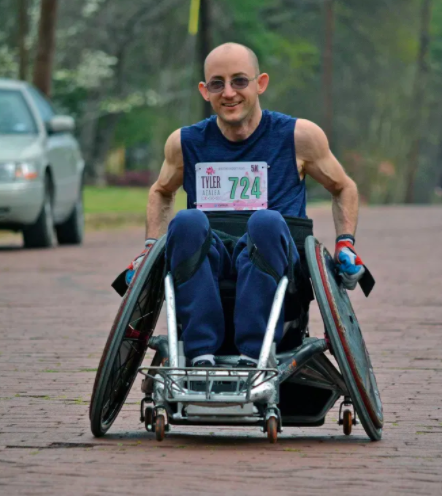
Nutrition for Athletes with Spinal Cord Injury
By: Jayden Chapman, MS, RD, LD, METS I, USAT Triathlon Coach
As seen on Performance RD.
The basic principles of sports nutrition are certainly relevant to athletes with spinal cord injury, but the application of these principles can be different due to some of the physiological changes that happen following an injury. Spinal cord injury (SCI) leads to changes in body composition, energy expenditure, GI transit time, sweat rate, and temperature regulation, all of which need to be accounted for when developing a nutrition plan.

Meeting the Energy Demands of Sport
The basal energy needs of people with SCI are typically decreased by changes in body composition, in particular loss of lean body mass below the level of injury, as well as by changes in mobility and activity level, however this group can still be at risk for underfueling in sport. Long term success in any sport is dependent upon taking in enough energy to fuel exercise on top of the energy needed for daily activity. The most common reasons for athletes to underfuel are dietary restriction to control weight, not increasing intake to account for increases in training volume, and underestimating the energy expended in exercise. Under fueling puts athletes at increased risk for poor recovery from training, injury, sexual dysfunction, and low bone density. Some of these symptoms may already be present as a result of SCI and could be made worse by under fueling.
Under fueling puts athletes at increased risk for poor recovery from training, injury, sexual dysfunction, and low bone density. Some of these symptoms may already be present as a result of SCI and could be made worse by underfueling.
Maintaining a healthy weight decreases risk for developing the most common chronic diseases, and also helps protect the skin from injury. Pressure sores are more likely to occur in those who are both overweight and underweight. Eating every three to five hours helps to regulate hunger, and including high calorie snacks between meals can help to meet increased energy needs during times of harder training.
Meeting Protein Needs
Athletes have an increased need for protein compared to non-athletes, and athletes with SCI are no exception. Getting enough energy and protein is important to performance and recovery, allowing the body to recover from the damage done during one workout to be stronger for the next. There’s not enough research to make recommendations specific to athletes with SCI, but protein needs can be elevated for many reasons, including increases in training load and recovery from injury. Protein also promotes satiety, helping you to feel full for longer. Including a source of protein at every meal and snack can help to ensure these needs are met.
Managing Hydration and Temperature Regulation
Adequate hydration is critical for any athlete, and can be a challenge to address in the case of athletes with decreased sweat rates or athletes who may not sweat at all. Athletes are at risk for overhydration when their intake exceeds their fluid losses. This can be exacerbated in hot environments, when thirst is increased. If you don’t sweat enough to regulate your body temperature, there are other cooling strategies that can be used. These can include drinking ice slurries before, during, and/or after exercise and using misters and fans. Training may also be adjusted to take place during cooler times of day, or moved indoors when possible. Heat acclimatization can help to prepare the body for hotter training and competitions, starting one to two weeks or more prior to the event. Selecting competitions that are in more ideal temperatures is also an option in some sports.
A fluid loss test can be a valuable tool in determining the amount of fluid that should be replaced during activity. This is done by weighing yourself in light, dry clothing before and after exercise to determine fluid loss over a given time period. For every pound lost, 16 ounces of fluid is needed to replace it. Staying adequately hydrated is important to optimal performance, and can also help prevent skin breakdown and decrease risk for UTIs.
Optimizing Gut Health
SCI can cause an increase in GI transit time. This can affect gut health, and potentially lead to an imbalance in the bacteria that normally live in the gut. Gut health has a direct impact on the immune system, so paying attention to this can help prevent illnesses that could get in the way of training. It can also help prevent GI distress that may occur during training. GI motility can be increased by exercise, adequate hydration, adequate fiber intake (15-30 grams per day), probiotics from supplements or food, and weight bearing activity (standing frames, etc.).
Using Supplements Safely and Effectively
Athletes looking for a boost in performance often turn to supplements. In addition to effects on performance, athletes with SCI may take supplements as part of prevention or management of secondary conditions that can accompany SCI. Some things to consider regarding dosage are that athletes with SCI often have decreased muscle mass and plasma volume, and may require a lower dose to achieve the same effect. Some supplements also have the potential to exacerbate symptoms, for example high doses of caffeine can increase spasticity or cause nausea. Secondary conditions are also often managed with medications. It’s important to be aware of any potential interactions between medication and supplements. Check with a healthcare provider to find out about any potential interactions with the medications you take.
Always choose supplements that have been third party tested to ensure you’re getting a safe product and that the contents match the label. Products certified by Informed Sport or NSF Certified for Sport have been tested and certified to contain no banned substances.
Putting it All Together
With all of this in mind, keep in mind that every body is different and every injury is different. A dietitian can help you to develop a personalized nutrition plan to move you closer to your goals.
Key points:
- Avoid skipping meals to help regulate hunger and maintain a healthy body weight.
- Include high calorie snacks between meals to meet increased energy needs
- Include a source of protein at every meal and snack
- Avoid over- and underhydration
- Implement cooling strategies to offset decreases in sweat rate
- Ensure supplements don’t interfere with medications or exacerbate other conditions, and consider adjusting the dose to account for differences in body weight. Choose third party certified supplements to ensure safety.

Jayden Chapman, MS, RD, LD, METS I, USAT Triathlon Coach and is a life long athlete with a love for triathlon. He is currently training for his first 70.3 half ironman. He enjoys supporting other athletes in their pursuit of health and sport through nutrition education and coaching. He also enjoys volunteering at races.
References:
- Bernardi M, Fedullo AL, Bernardi E, et al. Diet in neurogenic bowel management: A viewpoint on spinal cord injury. World J Gastroenterol. 2020;26(20):2479-2497. doi:10.3748/wjg.v26.i20.2479
- Broad E. Sports Nutrition for Paralympic Athletes. CRC Press. 2013.
- Figel K, Pritchett K, Pritchett R, Broad E. Energy and Nutrient Issues in Athletes with Spinal Cord Injury: Are They at Risk for Low Energy Availability? Nutrients. 2018;10(8):1078. doi:10.3390/nu10081078
- Flueck J, Perret C. Supplementation and Performance in Spinal Cord-Injured Elite Athletes : a Systematic Review. Ger J Sport Med. 2016;9(June):209-212. doi:10.5960/dzsm.2016.244
- Fraser C, Iruthayarajah J, McIntyre A, Serrato J, Benton B, Teasell R. Nutrition Issues Following Spinal Cord Injury.
- Gerrish HR, Broad E, Lacroix M, Ogan D, Pritchett RC, Pritchett K. Nutrient Intake of Elite Canadian and American Athletes with Spinal Cord Injury. Int J Sport Nutr Exerc Metab. 2017.
- Hopman M, Binkhorst R. Spinal Cord Injury and Exercise in the Heat. Gatorade Sports Science Institute. 2006.
- Jay O, Morris N. Cold Water and Ice Slurry Ingestion. Gatorade Sports Science Institute. 2018.
- Krempien J, Barr S. Eating attitudes and behaviours in elite Canadian athletes with a spinal cord injury. Eating Behaviors. 2012;13(1):36-41.
- Krempien J, Barr S. Risk of Nutrient Inadequacies in Elite Canadian Athletes With Spinal Cord Injury. Int J Sport Nutr Exerc Metab. 2011;21:417-425.
- Sawka M, Périard J, Racinais S. Heat Acclimatization to Improve Athletic Performance in Warm-Hot Environments. Gatorade Sports Science Institute. 2016.
- Shaw D. Nutritional Supplement Knowledge of Athletes with Spinal Cord Injury. 2012.



